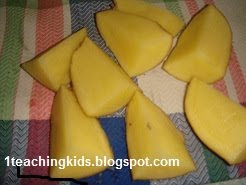I was quite pleased to see these few science questions in my son’s workbook yesterday. And as I was reading it to him – he could relate to the practical side of the question to look for the answer.
Here is an example of a question that combines science and ingriedients used in cooking. Its an example on how to apply cooking to teach science. And this simple principle could be applied to any age group. The explanations would of course differ depending on each individual child.
Question
Mr. Applebee’s class plans to bake a butter cake. Which of the following do you think is a science question that could be investigated while baking the cake?
(A) Do butter cakes rise?
(B) Which of cakes does the class prefer?
(C) Do butter cakes need baking powder to rise?
(D) How much does it cost to make 2 butter cakes?
The answer is C. We need baking powder to make a cake rise.

Explanation:
How does baking powder work? How does baking powder make the cake rise?
Baking powder and baking soda both produce carbon dioxide. Carbon dioxide is a gas that will ‘push’ the batter side-ways and upward. They raise baked products. Flat cakes and biscuits don’t look very tempting! Baking soda works best with an acidic ingredient. Baking powder contains both baking soda and a dry acidic ingredient, which raises the cake or biscuits even more than baking soda alone. Generally, 1 teaspoon of baking powder can be used for 1 cup of flour to help your cake rise.
Note: Just from one action in the baking process, your child learns:
(i) How to bake a butter cake of course;
(ii) What is carbon dioxide
(iii) How carbon dioxide works
(iv) What is baking powder and why and how it is used
(v) Introduce the concept of acidity
We could use this example in teaching our kids science concepts through the cooking process. Perhaps, in my next blog, I will provide some questions that could have handy in the kitchen for reference.
Happy Cooking and Teaching!
PS: Where to get or buy baking powder. Most supermarkets and neighborhood grocers would have it. I was also told that baking powder from Kalyx.com. is good for cakes and biscuits. I also found that the company also sells all sorts of other baking supplies. Many of friends love their goods.
Baking Powder Gluten Free - 4/16 Oz Baking Powder: GR

Here is an example of a question that combines science and ingriedients used in cooking. Its an example on how to apply cooking to teach science. And this simple principle could be applied to any age group. The explanations would of course differ depending on each individual child.
Question
Mr. Applebee’s class plans to bake a butter cake. Which of the following do you think is a science question that could be investigated while baking the cake?
(A) Do butter cakes rise?
(B) Which of cakes does the class prefer?
(C) Do butter cakes need baking powder to rise?
(D) How much does it cost to make 2 butter cakes?
The answer is C. We need baking powder to make a cake rise.

Explanation:
How does baking powder work? How does baking powder make the cake rise?
Baking powder and baking soda both produce carbon dioxide. Carbon dioxide is a gas that will ‘push’ the batter side-ways and upward. They raise baked products. Flat cakes and biscuits don’t look very tempting! Baking soda works best with an acidic ingredient. Baking powder contains both baking soda and a dry acidic ingredient, which raises the cake or biscuits even more than baking soda alone. Generally, 1 teaspoon of baking powder can be used for 1 cup of flour to help your cake rise.
Note: Just from one action in the baking process, your child learns:
(i) How to bake a butter cake of course;
(ii) What is carbon dioxide
(iii) How carbon dioxide works
(iv) What is baking powder and why and how it is used
(v) Introduce the concept of acidity
We could use this example in teaching our kids science concepts through the cooking process. Perhaps, in my next blog, I will provide some questions that could have handy in the kitchen for reference.
Happy Cooking and Teaching!
PS: Where to get or buy baking powder. Most supermarkets and neighborhood grocers would have it. I was also told that baking powder from Kalyx.com. is good for cakes and biscuits. I also found that the company also sells all sorts of other baking supplies. Many of friends love their goods.
Baking Powder Gluten Free - 4/16 Oz Baking Powder: GR



 Or you can
Or you can 





